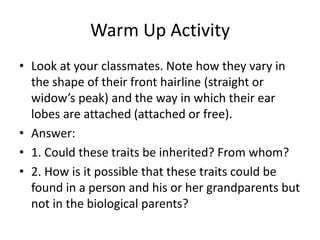
Inherited Traits Activity
- 1. Warm Up Activity Look at your classmates. Note how they vary in the shape of their front hairline (straight or widow’s peak) and the way in which their ear lobes are attached (attached or free). Answer: 1. Could these traits be inherited? From whom? 2. How is it possible that these traits could be found in a person and his or her grandparents but not in the biological parents?
- 2. Pick up a warm-up sheet from the back table by the door and get started. You may work with a partner to complete. Widow’s peak
- 3. Heredity Heredity is the process of passing physical and some behavioral characteristics from parents to their offspring. Genetics is the study of how heredity works. A trait is a physical characteristic inherited from one’s parents. e.g. hairline shape, ear lobe, etc. Can you think of any other traits that are inherited from your parents?
- 4. Genes and Alleles A gene is a section of DNA that has the code for a protein that determines a specific trait. e.g. the gene that is responsible for brown eyes codes for the protein melanin. Alleles are different forms of the gene for a trait. For example: The alleles for eye color. Blue eye color and brown eye color are different alleles for the same gene.
- 5. During sexual reproduction offspring are created when genetic material is combined from the mating of two separate individuals. Gametes are sex cells. In animals male gametes are sperm and female gametes are eggs. In plants, male gametes are pollen and female gametes are ovules.
- 6. GregorMendel’s Peas Austrian monk from Czech Republic – born in 1882 Lived at a monastery and was in charge of the garden. Mendel had several stocks of pea plants. These plants were true breeding, meaning that if they were allowed to self pollinate they would produce offspring identical to themselves. However,plants can also cross pollinate.
- 7. When pea plants cross pollinate, male sex cells in pollen from the flower on one plant fertilize the egg or ovule cells of a flower on another plant.
- 8. Genes and Dominance Mendel studied seven different pea plant traits. Each of the seven traits had two contrasting characteristics, i.e. short plants and tall plants or yellow seeds and green seeds. Mendel crossed plants with contrasting characteristics and observed their offspring.
- 9. Mendel called each original pair of plants the P or “parental” generation. He called the offspring the F1 or “first filial” generation. The offspring of crosses between plants with different traits are called hybrids.
- 10. What did the F1 hybrids look like? Mendel was surprised to find that the hybrids had the character of only one of the parents! The character of the other parent seemed to have disappeared! Why was he surprised?
- 11. Mendel’s first conclusion Biological inheritance is determined by factors that are passed from one generation to the next. Today we know that those factors are called genes. Each trait that Mendel studied was controlled by one gene that occurred in two contrasting forms. The different forms of a gene are called alleles.
- 12. Mendel’s second conclusion Mendel’s second conclusion is called the principal of dominance. The principal of dominance states that some alleles are dominant and others are recessive. An organism with a dominant allele for a particular form of a trait will always have that form, i.e. tall plants An organism with a recessive allele for a particular form of a trait will have that form only when the dominant allele for the trait is not present, i.e. short plants.
- 13. Dominant and Recessive Alleles In genetics dominant alleles are designated with a capital letter and recessive alleles are designated with a lower case letter. For example: The allele for a tall pea plant is dominant and is represented by an uppercase “T”. The allele for a short pea plant is dominant and is represented by a lowercase “t”.
- 14. Segregation Mendel wondered: Have the recessive alleles disappeared or are they still present in the F1 hybrid plants? To answer this he crossed an F1 hybrid plant with another F1 hybrid plant to produce an F2 plant!
- 15. The F1 cross Remarkable! The traits controlled by recessive alleles reappeared! Approximately ¼ of the F2 plants had recessive traits.
- 16. Explaining the F1 cross Mendel assumed that a dominant allele had masked the corresponding recessive allele in the F1 generation. However the recessive trait showed up in the some of the F2 generation plants. This reappearance means that at some point the recessive allele was separated or segregated from the dominant allele. These alleles were segregated during the formation of the sex cells (during meiosis).
- 17. Explaining the F1 cross When each F1hybrid plant flowers (producing the sex cells pollen and ovules), the two alleles are segregated from each other (during Meiosis II)so that each gamete carries only a single copy of each gene. Therefore, each F1hybrid plant produced two types of gametes – those with the dominant allele and those with the recessive allele.
- 18. Exit ticket: Think Pair Share If a true-breeding tall pea plant is crossed with a true-breeding dwarf (short) pea plant what will the offspring of this cross look like?
Hinweis der Redaktion
- Yes! From your parents.Genes are passed from generation to generation but are not all expressed in every generation.
- Filius is the Latin word for son.